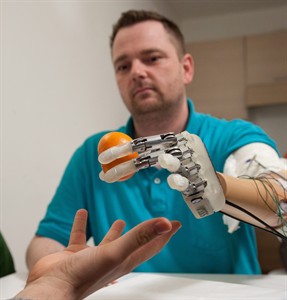
HEALTHBEAT: Scientists add sense of touch to robotic hand, a step to more lifelike prosthetics
WASHINGTON – European researchers have taken a step toward prosthetics with a sense of touch: They created a robotic hand that let an amputee feel differences in the shape and hardness of different objects, and adjust his grasp in response.
The patient only got to experiment with the bulky prototype for a week, and it will take years of additional research before prosthetics that feel become a reality.
But Wednesday’s report shows it’s possible. Swiss and Italian researchers surgically implanted tiny electrodes into nerves in the man’s arm. They put sensors on two fingers of a robotic hand. Then they connected the two. The electrodes zapped the man’s nerves in proportion to what the sensors touched — so he could tell if objects were hard or soft or round.
Join the Conversation!
Want to share your thoughts, add context, or connect with others in your community? Create a free account to comment on stories, ask questions, and join meaningful discussions on our new site.













Leave a Reply
You must be logged in to post a comment.